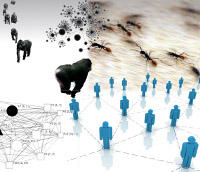Orateur
Dr
Cédric Sueur
(Institut Pluridisciplinaire Hubert Curien)
Description
In most animal and human populations, not everybody interacts with everybody else and we see a highly structured social organization that reflects differences between individuals in the number of their social interactions, the degree to which some individuals are central or peripheral to the population network, and the tendency to interconnect different communities that form substructures within networks. More recent “evolutionary graph theory” models use networks to quantify social heterogeneity and account for it, in models of, for example, the evolution and maintenance of cooperation. Social network analyses are a powerful tool used to assess individuals’ associations from the population to the group level. There is now growing support for the concept that the structure of a network is linked to its functioning, and is thus selected in order to increase the fitness of its members. Different examples in mammals or insects not only emphasize how individual characteristics (temperament, physiology, sociality, etc.) can influence a network, but also how the network influences individual behaviour via a feedback loop. Several studies showed that social networks constrain many social phenomena such as information or disease transmission. For instance, some key individuals may favour the diffusion of information or disease by their position in the network. How individuals are connected together in social species, and also how these connections may favour the information flow and enhance the decision efficiency are still unknown. We need now to better understand how the structure of social network may enhance fitness of group members and how this structure might be evolutionary selected.
Auteur
Dr
Cédric Sueur
(Institut Pluridisciplinaire Hubert Curien)

